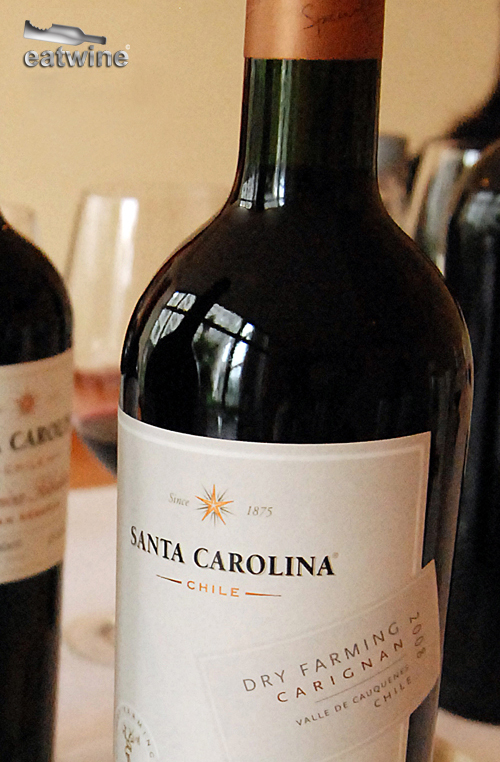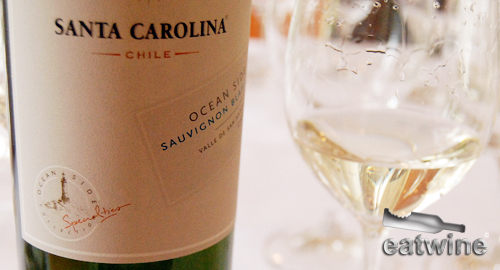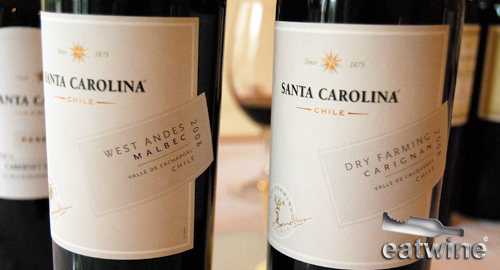As I’d talked about in an earlier post, Santa Carolina as a winery has undergone a profound change from viticulture, to winemaking, to marketing and corporate image. It’s fresh, new, and innovative, thriving on young blood and a lot of ganas, as we say in Chile. Their new line of wines seeks new, single vineyard terroirs where the grapes are in perfect balance with the soil and climate. Fun, off-the-beaten path areas and varietals. They call it the Specialities Collection—and these wines have me totally jazzed. That’s right, they are planting to a different drummer, looking for different fruit expression, finding balanced wines with tons of character and acidity. And the price point? Well, read to the end to find out. You may just be running out to Wain or Vinoteca (if you’re in Chile) to get them, or ordering them online.
Dry Farming Carignan (Cauquenes)
Not familiar with Carignan? Take note. It’s quickly becoming another uniquely Chilean varietal. Originally from Cariñena, Aragaon, it was planted throughout France, Italy, and even Sardinia for it’s high yield capacity. It has always been an underdog grape until now. Chilean vintners discovered abandoned vineyards in the Cauquenes area in the Maule Valley (nearly 4 hours south of Santiago) and started recouping these vines. Given the vines are old, from 80+ years, irrigation is not needed due to high development of the vines root system. The rain during fall season is enough to ensure water supply to the plants and the sun ripens the grapes perfectly over the long, hot and dry Chilean summer. With natural hydric stress and cutting back on yield, I think the results are really interesting.
Tasting wise, this is a dark ruby-colored wine. Aromas of red and dark berry preserves are complicated by cracked pepper, spices and a lightly floral note. In the mouth, I love the yielding blackberry and candied cherry flavors. Tannins are so easy to drink and behind all that lush fruit is a mineral component (so common in Chile). It’s got an edge to it though. It’s not a flabby wine. We have paired this successfully with numerous foods from pizza to roasted chicken, Moroccan dishes, Indian curries (not too spicy), roasted veggies, and butternut squash soup. Key words? Berry-laden, earthy, soft, yummy.
Oceanside Sauvignon Blanc from Santo Domingo (San Antonio)
While Santo Domingo may be an Oceanside resort for many wealthy Chileans in the summer, just outside in the campo, there are many avocado plantations and vineyards. The San Antonio vineyards are located on the central coast of Chile facing the Pacific Ocean. The ocean breeze refreshes the grapes and cool mornings are followed by warm afternoons, providing the perfect combination for concentrating flavors and aromas. The rocky soils give well-balanced acidity and minerality for a fresh, crispy and fruity Sauvignon Blanc.
I really think this wine is one of the purist expressions of Chile’s cool coast. I am not kidding folks, run don’t walk, to procure this delicious Sauvignon Blanc. It’s not even “typical” for Chile, which has gone as of late, thankfully, in the New Zealand-style direction. This is more akin to its European peers. It’s saline, briny, with notes of lemon zest and flint. It has a blinding acidity, one that perks up your palate, makes it water, and says “yeah baby, gimme another sip.” Crisp, clean and awash in minerals, this is a terrific buy for any seafood lover. So what to pair? Seafood. If you’re not a raw lover, sorry, this wine seems to be made for it. Order up some ostras de borde negro, sushi, tiradito, maybe some yellowtail or corvina gravlax. If I have to cook it, I will stick with machas pil pil. Awesome.
West Andes Malbec (Cachapoal)
Take note, Chile is conquering Malbec. Yes sir, no longer relegated only to Argentina, the Chilean expressions are less jammy and more balanced, with fresher fruit, a mineral component and less alcohol. A Malbec revolution on the other side of the Andes? Time will tell. In any case, the name is fitting (Chile is the west side of the Andes, Argentina east, fyi). Santa Carolina and their talented winemaker Alejandro Wedeles have really nailed the terroir for this variety. The Rinconada vineyards are located in the heart of Cachapoal Valley near, what used to be, the Rapel lake (it’s drying up!). The vineyard is west enough to get a cooling maritime effect but is also warm enough to ripen. This is not a hot, desert climate like Mendoza. It produces a full bodied, fruit forward Malbec—but it won’t hit you over the head.
So how does it taste? It is a full-bodied, deep red wine with a lot of complexity on the nose and notes of dark plums and anise. There are subtle “oaky” notes and the fruit gets darker and deeper in your mouth. The tannins are structured and can stand up alone but round and never gripping. What to eat? How about a warm potato-chorizo salad; some figs wrapped in prosciutto stuffed with goat cheese; or a grilled steak with some salsa criolla. Pair anything with meaty, spicy notes.
I won’t leave you hanging any longer. Price point is around US$15 (7,500 pesos). A deal? I call it a steal for the quality and uniqueness. But I’ll leave that up to you to decide.
















